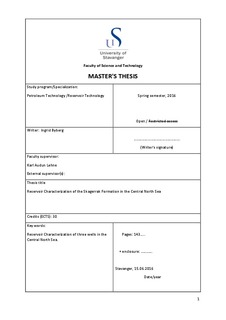| dc.description.abstract | A petrophyscial evaluation has been generated for three wells penetrating the Skagerrak
Formation in the Sleip
ner Øst field, the Gungne field,
and the Loke field in the Central North
Sea, Figure
5 - 1. The wells included in this study
were
15/9 - 9, 15/9 - 15 and 15/9 -
17.
The porosity
was
the result of calibrating core porosity with the density log. In addition clay
volume was included to create an effective porosity.
Pressure data from RFT and logs
were
utilized to find the fluid contact, and the pressure gradients defined the fluid densities used in the evaluation.
The calculated permeability, KLOGH,
was estimated by regression analysis between the
overburden corrected core permeability
and
core
porosity.
The result was
a poorly
correlation. The water saturation modelling has been estimated with three main methods:
* use of logs: Indonesia-, Waxman Smits-, and Archie's method.
* use of cores
* use of a combination of log- and core- evaluated saturations.
A pressure transient analysis was performed from DST1 in well 15/9-15, Gungne Field, where the main objectives were to compare the permeability estimated from the test with the core permeability and look at potential barriers in the reservoir. Three different fault models were estimated in an attempt to match the measured data, one fault, parallel fault, intersecting faults.
A brief sedimentological evaluation of the Skagerrak Formation was implemented in all three wells based on available log data and core data. The well 6510/7-2 from the Norwegian Sea comprising red beds were compared to the Skagerrak Formation to find that the all the wells are comprising fluvial systems in their respectively Skagerrak Formation. The main difference however was the porosity properties, which implied a much lower porosity in well 6510/7-2. | nb_NO |
